Making a QR code for a link is simple, and you don’t need paid QR solutions to create it. Many QR code generators offer it for free, whether static or dynamic.
Today, it’s almost impossible to imagine anyone promoting themselves or their brands without using digital platforms. Whether you’re an online educator, social influencer, freelancer, or business owner, having a website, social media handle, or YouTube account is a minimum requirement.
To reach a wider audience, you can quickly and effectively promote your digital content or products using QR codes. The best thing you can do is create a QR code for your promotional links.
This article will help readers understand the benefits of using a QR code for a link and share the simplest ways to create it for your digital platforms.
- What is a QR code for a link?
- Simple steps to generate a QR code for a link
- Benefits of using a QR code for a link
- Best practices for creating a QR code for a link
- How can you use a website QR code?
- More ways to generate QR codes for links with QRCodeChimp
- What if I do not have my own website?
- Conclusion
- Frequently asked questions
What is a QR code for a link?
A QR code for a link is a dedicated QR code that connects users to a particular URL. Upon scanning the QR code, users get redirected to a specific website, social media page, or YouTube page.
One significant advantage of using QR codes is that users can visit a site by scanning them, eliminating the chance of forgetting the URL or manually entering it. In a nutshell, QR codes are a digital bridge between the physical world and your online presence.
Simple steps to generate a QR code for a link
You can create QR codes for your page links using QRCodeChimp’s QR code generator. Sign up for an account at QRCodeChimp and follow these steps to create a QR code for a link:
Step 1: Go to qrcodechimp.com
Log in to QRCodeChimp and select the URL solution.
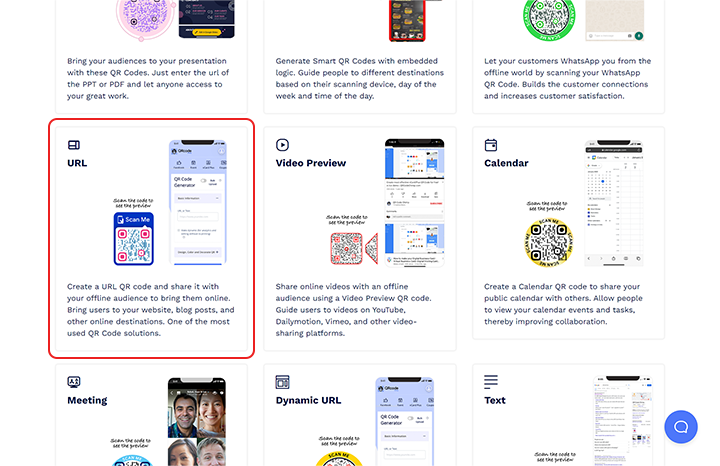
Step 2: Enter your link
Copy the link/URL for which you want to create a QR code and paste it into the “Website or page URL.”
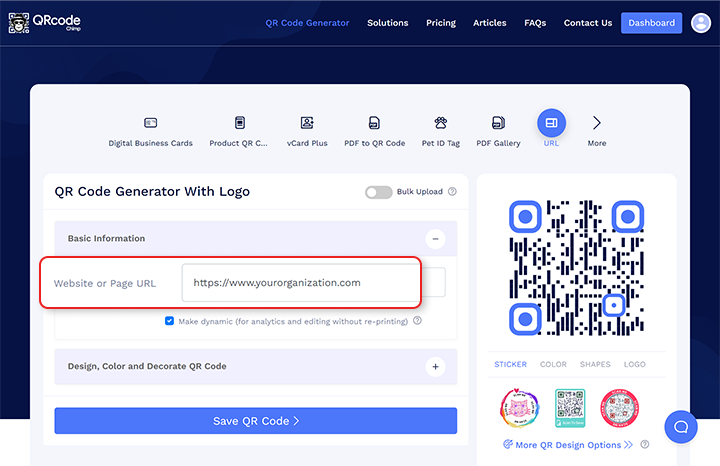
Step 3: Choose dynamic QR codes
Check the “Make dynamic” box to create a dynamic QR code. Dynamic QR codes enable editing and allow you to view their scan analytics.
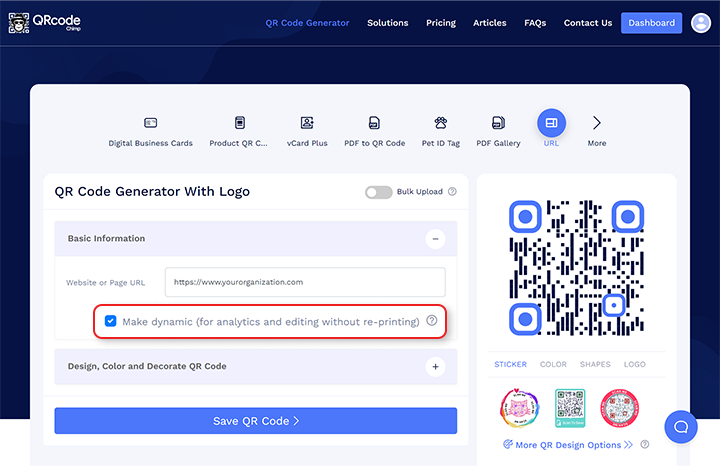
Step 4: Design and customize
Go to the “Design, Color, and Decorate QR Code” section and customize your QR code using QR shapes, pre-designed stickers, colors, shapes, and logos. You can also decorate your picture.
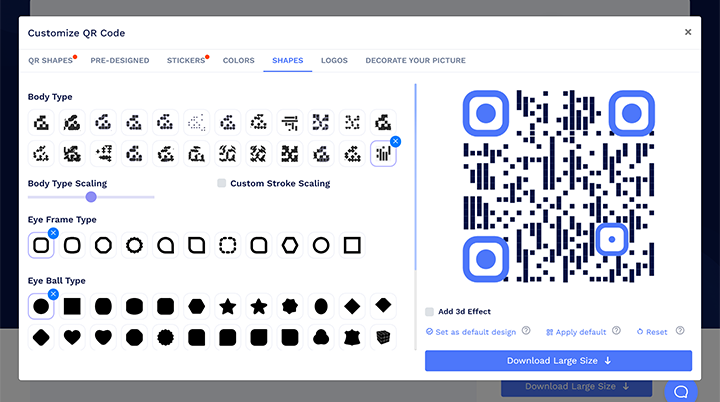
Step 5: Save and download
Click on “Save QR Code. Enter a name, select a folder (optional), and click “Save.” Your QR code will be saved in the dashboard, where you can download and edit it.
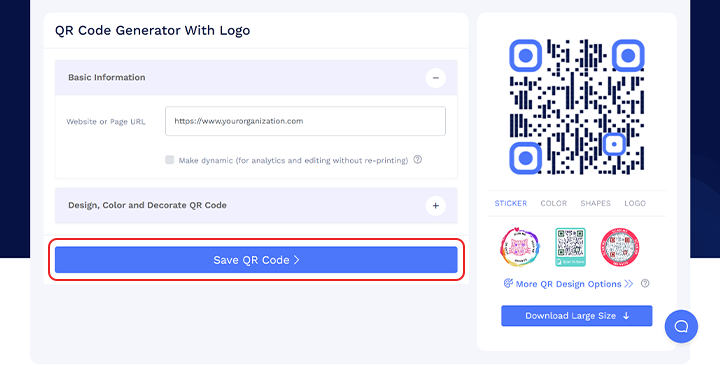

Benefits of using a QR code for a link
If you want to share your website URL or any other link with an offline audience, the best approach is to create a QR code. You can print the QR codes on flyers & brochures, product packaging, billboards, and event displays to redirect customers or users to your website, etc.
Here are the key benefits of using a QR code that links to your website or other special sites:




Best practices for creating a QR code for a link
Here are some practical tips and best practices to remember before creating a QR code for a link:








How can you use a website QR code?
Website or URL QR codes are the most popular type of QR code businesses use. A website QR code can be used in various contexts, including:




More ways to generate QR codes for links with QRCodeChimp
You can use many more QR code solutions from QRCodeChimp to share your page links or URLs. For instance, you can use a product QR code by creating a landing page for specific promotional activities.
Here are two QR code solutions you can additionally use to link to your websites or any URL.
Multi-URL QR code
Multi-URL shows a page with multiple links or URLs to your website, social media handles, portfolios, etc. When people scan this QR code, they see a landing page with all your links in one place.
For instance, an online fashion store can utilize a multi-URL QR code to direct customers to a landing page with options to visit the main website, check out live deals, or explore new arrivals. By offering direct links to specific interests, the store improves the shopping experience and facilitates quick access to high-demand areas like promotions and new products.

Business QR code
A business QR code shows people essential information about your company and products. When scanned, it directs users to your business display page with information on your company’s name, address, opening hours, website, and more.
This landing page also includes links to their social media profiles, promoting further interaction with the brand and helping to enhance brand visibility.
What if I do not have my own website?
If you don’t own a website, you can still share your business information using a business or landing page QR code. The Landing Page QR code allows you to add HTML code, enabling you to design and create your own webpage hosted on QRCodeChimp.
On the other hand, the business QR code includes pre-set fields commonly used by businesses to share essential details with customers. You can easily customize these fields by adding or removing components to suit your specific needs.
Conclusion
Using a QR code for a link makes marketing easy. It enables you to bring users to your website, landing page, or social media page, increasing organic traffic and engagement with your audience. This versatile tool allows you to maximize your efforts to reach more visitors or customers.
Frequently asked questions
Can I customize my website QR code?
Yes, QRCodeChimp allows you to customize your website QR codes by changing colors, adding logos, and selecting design patterns to match your branding.
Where can I use my website QR code?
You can use your website’s QR code on business cards, flyers, posters, product labels, and digital displays. You can also integrate it into your email signatures and social media profiles to increase visibility.
How can QR codes drive traffic to a website or YouTube?
By including a QR code in marketing materials, businesses can encourage people to scan the code and visit their website, which increases traffic.
What are the benefits of using QR codes for websites?
QR codes provide a convenient and efficient means for users to access a website, and they can be integrated into marketing campaigns to enhance user engagement.
You may also like
SMS Integration in Forms on QRCodeChimp
Learn the steps for SMS integration in forms using QRCodeChimp. Create an account level to get SMS notifications on all forms and a form level for specific forms.
The Ultimate Guide to QR Code White Labeling: Boost Branding and Conversions
If you're using QR codes, you need to stand out. Here's an ultimate guide to QR code white labeling, including how to set it up and it's benefits and best practices.
How to Create a White Label Digital Business Card?
This guide will walk you through creating a white-label digital business card to streamline your network and improve brand consistency.
A Complete Guide to QR Code White Labeling
QRCodeChimp offers white labeling to users with the Ultima plan and above. By enabling white labeling, you can use your company's domain (like info.MyBusiness.com) instead of the default scan URL and landing page URL. Here's all you need to know...
Most Popular
Contact Sales
